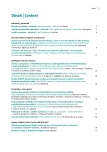The SPRINT Research. A Randomized Trial of Intensive versus Standard Blood-Pressure Control
Authors:
Jiří Widimský
Authors‘ workplace:
Klinika kardiologie IKEM, Praha
Published in:
Vnitř Lék 2016; 62(1): 44-47
Category:
Reviews
Overview
Background:
The most appropriate targets for systolic blood pressure to reduce cardiovascular morbidity and mortality among persons without diabetes remain uncertain.
Methods:
We randomly assigned 9 361 persons with a systolic blood pressure of 130 mm Hg or higher and an increased cardiovascular risk, but without diabetes, to a systolic blood-pressure target of less than 120 mm Hg (intensive treatment) or a target of less than 140 mm Hg (standard treatment). The primary composite outcome was myocardial infarction, other acute coronary syndromes, stroke, heart failure, or death from cardiovascular causes.
Results:
At 1 year, the mean systolic blood pressure was 121.4 mm Hg in the intensive treatment group and 136.2 mm Hg in the standard-treatment group. The intervention was stopped early after a median follow-up of 3.26 years owing to a significantly lower rate of the primary composite outcome in the intensive-treatment group than in the standard-treatment group (1.65 % per year vs 2.19 % per year; hazard ratio with intensive treatment, 0.75; 95% confidence interval (CI) 0.64 to 0.89; p < 0.001). All causes mortality was also significantly lower in the intensive-treatment group (hazard ratio, 0.73; 95% CI 0.60 to 0.90; p = 0.003). Rates of serious adverse events of hypotension, syncope, electrolyte abnormalities, and acute kidney injury or failure, but not of injurious falls, were higher in the intensive-treatment group than in the standard-treatment group.
Conclusions:
Among patients at high risk for cardiovascular events but without diabetes, targeting a systolic blood pressure of less than 120 mm Hg as compared with less than 140 mm Hg, resulted in lower rates of fatal and nonfatal major cardiovascular events and death from any cause, although significantly higher rates of some adverse events were observed in the intensive-treatment group. Funded by the National Institutes of Health.
Key words:
intensive treatment of hypertension – rates of serious adverse – SPRINT
Sources
1. Wright JT, Williamson PK, Snyder JK et al. A Randomized Trial of Intensive versus Standard Blood-Pressure Control. N Engl J Med 2015; 373(22): 2103–2116.
2. Perkovic V, Rodgers A. Redefining Blood-Pressure Targets – SPRINT starts the Marathon. N Engl J Med 2015; 373(22): 2175–2178.
3. Drazen JM, Morrissey S, Campion EW et al. A SPRINT to the Finish. N Engl J Med 2015; 373(22): 2174–2175.
4. Yeh JS, Bakris GL, Taler SJ. CLINICAL DECISIONS. Blood-Pressure Control. N Engl J Med 2015; 373(22): 2180–2182.
5. ACCORD Study Group, Cushman WC, Evans GW et al. Effect of intensive blood pressure control in type 2 diabetes mellitus. N Engl J Med 2010; 362(17): 1575–1585.
6. Cushman WC, Evans GW, Cutler JA. Long-term cardiovascular effects of 4.9 years of intensive blood pressure control in type 2 diabetes mellitus: The Action to Control Cardiovascular Risk in Diabetes: follow-on blood-pressure study. American Heart Association 2015 Scientific Sessions: 2015. Orlando (FL). Abstract. Dostupné z WWW: <https://my.americanheart.org/idc/groups/ahamah-public/@wcm/@sop/@scon/documents/downloadable/ucm_478891.pdf>.
7. Chobanian AV. Time to ASSESS Blood-Pressure Goals. N Engl J Med 2015; 373(22): 2093–2095.
Labels
Diabetology Endocrinology Internal medicineArticle was published in
Internal Medicine

2016 Issue 1
Most read in this issue
- Toxic epidermal necrolysis
- Changes in the prognosis and treatment of Waldenström macroglobulinemia. Literature overview and own experience
- Significance of alanine aminotransferase screening in blood donors for risk reduction of hepatitis B and C transmission by haemotherapy
- Gene mutations connected to Waldenstöm macroglobulinemia
